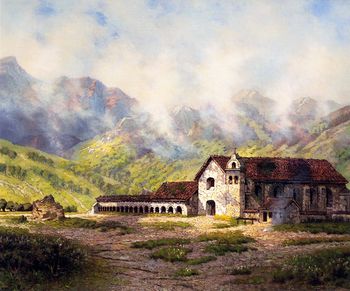Mission Santa Inés
| This article is part of a series on the Spanish missions in California  Mission Santa Inés in 1875.[1] | |
| HISTORY | |
|---|---|
| Location: | Solvang, California |
| Coordinates: | 34° 35′ 40.16″ N, 120° 8′ 11.77″ W |
| Name as Founded: | La Misión de Nuestra Santa Inés, Virgen y Mártir [2] |
| English Translation: | The Mission of Saint Agnes of Rome, Virgin and Martyr |
| Patron Saint: | Saint Agnes of Rome, Italy [3] |
| Nickname(s): | "Hidden Gem of the Missions" [4] "Mission of the Passes" [5] |
| Founding Date: | September 17, 1804 [6] |
| Founded By: | Father Presidente Pedro Estévan Tápis [7] |
| Founding Order: | Nineteenth [3] |
| Military District: | Second [8] |
| Native Tribe(s): Spanish Name(s): |
Chumash Inéseño |
| Primordial Place Name(s): | 'Alahulapu [9] |
| SPIRITUAL RESULTS | |
| Baptisms: | 1,348 [10] |
| Marriages: | 400 [10] |
| Burials: | 1,227 [10] |
| Year of Neophyte Population Peak: | 1815 [11][12] |
| Neophyte Population: | 360 [11][12] |
| Neophyte Population in 1832: | 768 [11][12] |
| DISPOSITION | |
| Secularized: | 1836 [3] |
| Returned to the Church: | 1862 [3] |
| Caretaker: | Roman Catholic Diocese of Los Angeles |
| Current Use: | Parish Church / Museum |
| Current Land Area: | 95 acres |
| National Historic Landmark: | NPS–99000630 |
| California Historical Landmark: | #305 |
| Web Site: | http://www.missionsantaines.org |
Mission Santa Inés is a former religious outpost established by Spanish colonists on the west coast of North America in the present-day State of California (U.S. state). Founded on September 17, 1804 by Roman Catholics of the Franciscan Order, the settlement was the nineteenth in the twenty-one mission Alta California chain. Named after a 4th-century Roman martyr, the Mission was home to the first learning institution in Alta California. Designated as a historic landmark at both the state and national levels, today the Mission serves as a museum and as a parish church.
History
Mission Period (1769 – 1833)
The Mission site was chosen as a midway point between Mission Santa Barbara and Mission La Purísima Concepción, and was designed to relieve overcrowding at those two missions and to serve the natives living east of the Coast Range. On February 21, 1824 a soldier beat a young Chumash Indian and sparked a revolt. Some of the Indians went to get the Indians from the settlements at Santa Barbara and La Purísima to help in the fight. When the fighting was over, the Indians themselves put out the fire that had started at the Mission. Many of the Indians left to join other tribes in the mountains; only a few Indians remained at Santa Inés.
Rancho Period (1834 – 1849)
California Statehood (1850 – 1900)
President Abraham Lincoln signed a proclamation in 1861 that restored ownership of the Mission proper to the Roman Catholic Church.
20th century and beyond (1901 – present)
The Danish town of Solvang was built up around the Mission proper in the early 1900s. It was through the efforts of Father Alexander Buckler in 1904 that reconstruction of the Mission was undertaken, though major restoration was not possible until 1947 when the Hearst Foundation donated money to pay for the project. The restoration continues to this day under the direction of the Order of Friars Minor Capuchin Franciscan Fathers.
Notes and references
- ↑ (PD) Painting: Edwin Deakin
- ↑ Leffingwell, p. 71
- ↑ 3.0 3.1 3.2 3.3 Krell, p. 286
- ↑ Ruscin, p. 163
- ↑ California Missions Foundation
- ↑ Yenne, p. 164
- ↑ Ruscin, p. 196
- ↑ Forbes, p. 202
- ↑ Ruscin, p. 195
- ↑ 10.0 10.1 10.2 Krell, p. 315: as of December 31, 1832; information adapted from Engelhardt's Missions and Missionaries of California.
- ↑ 11.0 11.1 11.2 Krell, p. 315: Information adapted from Engelhardt's Missions and Missionaries of California.
- ↑ 12.0 12.1 12.2 Engelhardt 1920, pp. 300-301